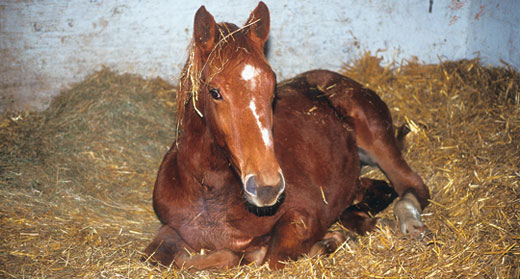 1. Potomac Horse Fever (PHF)
1. Potomac Horse Fever (PHF)
What it does: A bacteria that causes
colic like symptoms that eventually may lead to laminitis and death.
Signs and Symptoms: Acute fever, depression, lack of appetite, mild colic, diarrhea, edema, acute laminitis,
death from laminitis leading to founder.
Treatment: PHF is diagnosed by blood tests and the bacteria responds well to antibiotics in the tetracycline
family. Your vet may also include the use of fluids to help keep your horse hydrated and to help flush the
bacteria out, and may use things such as charcoal in the diet to help absorb the bacteria and flush it
out.
2. Equine Infectious Anemia or Swamp Fever
What it does:
No matter what else it does, this disease is often fatal and always contagious. Horses that do survive, live
with the symptoms all their lives and must be euthanized or quarantined as they remain highly contagious.
Signs and Symptoms: Fever, loss of appetite, weight loss, anemia, muscle weakness. Some horses can carry the
virus without showing symptoms.
Treatment: There is no treatment for Swamp Fever. Horses must be tested with a Coggins test, a small blood test
which checks for the antibodies, especially before interacting in shows and parades with other horses and the
disease can spread swiftly.
3. Eastern, Western, and Venezuelan Encephalomyelitis (EEE, WEE,
VEE)
What it does: All three varieties cause inflammation on the brain and spinal cord and are
deadly. The Venezuelan form (VEE) can be transmitted from horses to humans and is equally deadly for both.
Signs and Symptoms: High fever, depression, rapid heart rate, no appetite, unusual aggression, aimless
circling, leaning or pressing against wall, muscle spasms and twitching, convulsions, collapse, death.
Treatment: Vaccination is the only protection against these diseases. It is recommended annually and as much as
twice a year in areas where mosquitos are prevalent. There is no treatment for the disease itself, most
treatments focus on relieving pressure on the brain and spinal cord.
4. West Nile Virus (WNV)
What it does: Causes swelling of
the brain and spinal cord.
Signs and Symptoms: Fever, stumbling, loss of muscle coordination, partial paralysis, loss of appetite, walking
in circles, walking into things.
Treatment: The only course of treatment is prevention. There is a vaccine to protect your horses from this
disease. Mosquito control is also an excellent idea both for yourself and your horses as humans can contract
the disease from mosquito bites as easily as a horse. Symptom relief is the only other treatment
available.
5. Lyme Disease
What it does: Causes general muscle
soreness, fever
Signs and Symptoms: Less than ten percent of horses show symptoms. The most common symptom is an appearance of
general stiffness and discomfort, refusal to work and crabbiness.
Treatment: Treatment is in antibiotic form and a full course of treatment may take several weeks, though you
horse may show signs of improvement within days. Diagnosing the disease can be difficult and a vet may choose
to treat for lyme disease just in case. If your horse does not respond quickly chances are they do not have the
disease. Anti-inflammatories may be prescribed to help control stiffness, and stomach medicine to help control
upset stomach issues.
Related Articles
Breaking a Leg- What It Means For Your
Horse
Deadly Equine Diseases
Tips for Keeping Flies Under
Control
Horse Inspection Checklist
Five Most Common Horse Diseases
How to Spot a Malnourished Horse
Top 10 Most Poisonous Plants for Horses
Feeding and Rebuilding a Malnourished
Horse
Helping a Horse Living with Cushing's
How to Treat Abscesses on Your Horse
Colic and Your Horse
Confirming That Your Horse Has Rabies
Helping a Pregnant Mare
Handling a Rattlesnake Bite to Your Horse
Being Aware of Tetanus and Your Horse
Preventing Thrush in Your Horse